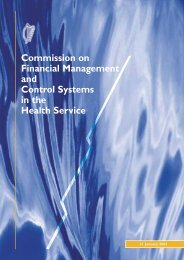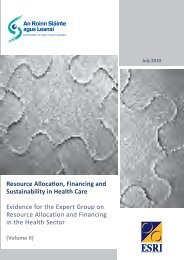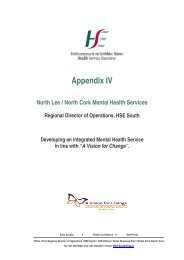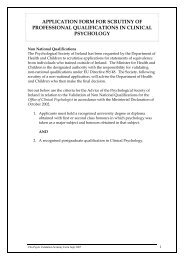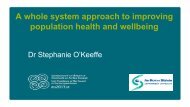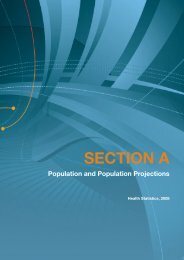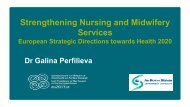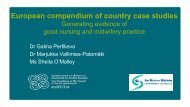All Ireland Traveller Health Study Our Geels - Department of Health ...
All Ireland Traveller Health Study Our Geels - Department of Health ...
All Ireland Traveller Health Study Our Geels - Department of Health ...
Create successful ePaper yourself
Turn your PDF publications into a flip-book with our unique Google optimized e-Paper software.
<strong>Health</strong> Survey Findings<br />
Section B1: Child <strong>Health</strong> (<strong>All</strong> Children)<br />
General Summary<br />
Information was collected on 1,380 children in ROI: 521 5-year-olds, 399 9-year-old and 460 14-yearolds.<br />
In NI, a total <strong>of</strong> 183 child health interviews were conducted with the adult respondents, with 61<br />
responses for 5-year-olds, 65 for 9-year-old and 57 for 14-year-olds.<br />
The majority (64.6% ROI and 55.7% NI) <strong>of</strong> both male and female children were reported as weighing<br />
between 3 and 4 kg at birth. Older children in a family tended to have been relatively lighter at birth<br />
than the subsequent <strong>of</strong>fspring. Most children (56.9% ROI and 65.9% NI) were born at full term (i.e.<br />
between 37 and 41 weeks <strong>of</strong> gestation), a pattern similar according to age and sex in both jurisdictions.<br />
The breastfeeding rate for children overall was 5.6% in ROI and 7.1% in NI.<br />
In ROI and NI, 90.3% and 97.3% <strong>of</strong> children respectively were reported as having no ongoing health<br />
problem. For those children who had a health problem, the number one reported condition was<br />
asthma, which accounted for 71.9% <strong>of</strong> reports <strong>of</strong> chronic conditions in childhood in ROI. There were<br />
much lower rates reported for other conditions, including inborn errors <strong>of</strong> metabolism. Patterns were<br />
similar for both male and female children, with asthma the most frequently reported adverse chronic<br />
health condition in each age group. Chest infection was the most commonly cited recent acute<br />
condition. Around a quarter <strong>of</strong> children (22.9% ROI and 26.0% NI) were reported to have ever had an<br />
accident, boys more frequently than girls in ROI but not in NI and older children more frequently than<br />
younger ones. The most frequently reported type <strong>of</strong> injury in both ROI and NI was a fall.<br />
41% <strong>of</strong> <strong>Traveller</strong> children in ROI and 47.6% in NI had visited a hospital Accident and Emergency<br />
<strong>Department</strong> (A & E) in the previous 12 months, and 36.5% <strong>of</strong> children in ROI and 43.9% in NI had done<br />
so on 1 to 3 occasions. Again the gender and age group variation was small.<br />
10% <strong>of</strong> children in ROI and 7.8% in NI had stayed at least 1 night in hospital in the last year, with<br />
little variability according to age group or sex. The most frequent length <strong>of</strong> stay was 1 to 3 nights, as<br />
indicated by 66.7% <strong>of</strong> those hospitalised. Younger children had the shortest length <strong>of</strong> stay. The most<br />
frequent indications for admission were infectious conditions, including fever or viral conditions,<br />
asthma and other non-surgical conditions.<br />
Both in ROI (58.4%) and in NI (58.5%), a majority <strong>of</strong> mothers reported adding regular salt to their<br />
child’s food while cooking. In ROI 26.8% and in NI 43.7% reported that their children ate five or greater<br />
portions <strong>of</strong> fruit and vegetables daily.<br />
193



